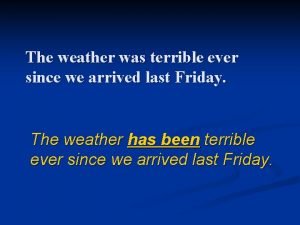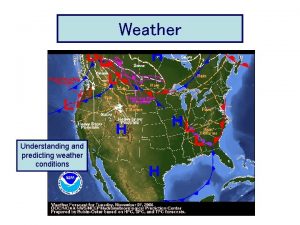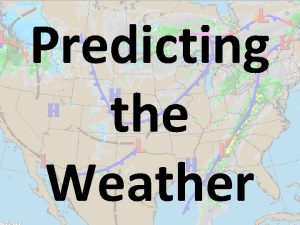How computing has changed weather predicting since 2004




- Slides: 4

How computing has changed weather predicting since 2004? By Alexander Barlow

How we predict weather today? • • There are many different ways of predicting weather today, so here a few. • The most accurate forecasters take into account the weather events that are happening over a bigger region. Knowing where storms are at the current time can help the forecasters tell where the storms will be the next day and the day after that. Technology such as weather satellites and Doppler radar, helps the process of looking over a large area, as does the network of weather observations. • Because of the way the atmosphere works we will probably never be able to tell what the weather will be like more than two weeks in advance, however , new technologies added with more traditional methods are allowing forecasters to develop better and more complete forecasts. • A Super computer predicting weather Some people go on trips for months in a remote location and often rely on their knowledge of the winds and clouds to know what the weather will be like in a few hours or in some cases the next day, but this method is not very accurate and can not be used several days into the future. Using mathematical calculations to predict weather, is not a job for the average calculator, or even your average desktop computer. You have to use a supercomputer which are capable of doing 2 billion operations a second, are fed weather information from satellites, weather stations, and other sources. To generate weather predictions, they perform many calculations that take into account the world wide factors such as air pressure differences, solar radiation, the Earth’s rotation, and the water cycle as well as current information. This allows forecasters to generate more accurate forecasts based on a complete regional perspective about current weather, instead of just observations of a single point.

History • Roughly 20 years ago, forecasters began to forecast with numerical prediction, a computer-based technique that takes data from multiple sources, and then spits out data. “You can make a one or two day forecast at almost any time during the year and it is just about guaranteed to be an accurate description of what the day will be like. ” • Predicting weather has gone a long way over the years since the first efforts it took the forecasters to know weather you would need an umbrella the next day or a snow shovel. • Numerical weather prediction began to stir in the 1950 s at the beginning of the computer age, and computers gathering in and endless amount of data from weather balloons, ground stations, ships, airplanes and satellites. They are all now the engines of weather predictions. • A fairly new instrument called an ABI can make an image of the weather in a minute where as GOES ( an existing satellite) takes 5 minutes. Even if the features appear the same in both images but you also have to wait another 15 minutes for both to be processed.

What happens next? • The COSMIC satellites are wearing out, and a dozen replacements are under development. The first six of those with significant support from Taiwan and the U. S government, are due for launch in 2016. • A new GOES satellite, scheduled for launch in 2015, will carry an instrument reading 16 channels of the electromagnetic spectrum. • Meteo-Logic, an Israeli start-up, is offering a new software solution that might be one of the most accurate prediction services for weather patterns. This project was started by someone asking whether they could plan an outdoor event at a certain time in a specific place. Until this new software was released you had to use expensive professional forecasting services to answer such questions.







